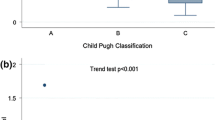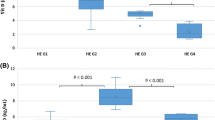Abstract
Our aim is to evaluate the serum zinc levels in Hepatitis B liver cirrhosis patients and clarify the relationship between the serum zinc levels and the development of hepatocellular carcinoma (HCC). From January 2009 to December 2019, 295 included patients diagnosed with Hepatitis B liver cirrhosis received nucleos(t)ide analogues (NUCs) therapy at China-Japan Union Hospital of Jilin University. Their comprehensive medical records were retrospectively analyzed, and to analyze the relationship between hypozincemia and hepatitis B-related HCC. Twenty-eight of 295 patients (9.49%) developed HCC during an observation period of the median follow-up time was 42 months. Compared with the non-zinc deficiency group, the zinc deficiency group is older, has a higher proportion of hepatic encephalopathy, higher levels of aspartate aminotransferase(AST), international normalized ratio(INR) and TB, and lower levels of cholinesterase (CHE), creatinine, and platelet counts (P< 0.05). Multivariate analysis showed that zine (HR=0.854, 95%CI 0.725–1.007; P=0.061), zinc is not significant for reducing the incidence of HCC, as liver disease progresses, the proportion of zinc deficiency is getting higher and higher, Child-Pugh C. The proportion of grade zinc deficiency accounted for 64.86%. Child-Pugh grade C was more than Child-Pugh grade B and A, p<0.001. Zinc deficiency is associated with hepatic encephalopathy, and other complications related to hepatitis B and liver cirrhosis. But the relationship with hepatocellular carcinoma still needs further study.



Similar content being viewed by others
References
Vallee BL, Falchuk KH (1993) The biochemical basis of zinc physiology. Physiol Rev 73(1):79–118
Wessels I, Maywald M, Rink L (2017) Zinc as a gatekeeper of immune function. Nutrients 9(12):1286
Leoni G, Rosato A, Perozzi G et al (2014) Zinc proteome interaction network as a model to identify nutrient-affected pathways in human pathologies. Genes Nutr 9(6):436
Wastney ME, Aamodt RL, Rumble WF et al (1986) Kinetic analysis of zinc metabolism and its regulation in normal humans. Am J Physiol 251(2):398–408
Alker W, Haase H (2018) Zinc and Sepsis[J]. Nutrients 10(8):976
Nishikawa H, Enomoto H, Yoh K et al (2019) Serum Zinc Concentration and Sarcopenia: A Close Linkage in Chronic Liver Diseases. J Clin Med 8(3):336
Stamoulis I, Kouraklis G, Theocharis S (2007) Zinc and the liver: An active interaction. Dig Dis Sci 52(7):1595–1612
Livingstone C (2015) Zine: Physiology, deficiency, and parenteral nutrition. Nutr Clin Pract 30(3):371–382
Prasad AS (2013) Discovery of human zinc deficiency: Its impact on human health and disease. Adv Nutr 4(2):176–190
Farooq M (2019) Zinc Defificiency is Associated with Poor Glycemic Control. J Coll Physicians Surg Pak 29(3):253–257
Sullivan JF, Jetton MM, Burch RE (1979) A zinc tolerance test. J Lab Clin Med 93(3):485–492
Chiba M, Katayama K, Takeda R et al (2013) Diuretics aggravate zinc deficiency in patients with liver cirrhosis by increasing zinc excretion in urine. Hepatol Res 43(4):365–373
Shigefuku R, Iwasa M, Katayama K et al (2019) Hypozincemia is associated with human hepatocarcinogenesis in hepatitis C virus-related liver cirrhosis. Hepatol Res 49(10):1127–1135
Chavez-Tapia NC, Cesar-Arce A, Barrientos-Gutiérrez T et al (2013) A systematic review and meta-analysis of the use of oral zinc in the treatment of hepatic encephalopathy. Nutr J 12:74
Hosui A, Kimura E, Abe S et al (2018) Long-Term Zinc Supplementation Improves Liver Function and Decreases the Risk of Developing Hepatocellular Carcinoma. Nutrients 10(12):1955
JiDong J, LanJuan L (2011) The guideline of prevention and treatment for chronic hepatitis B (2010 version). J Clin Hepatol 27(1):113–128
GuiQiang W, FuSheng W, Jun C et al (2015) The guideline of prevention and treatment for chronic hepatitis B (2015 version). J Clin Hepatol 31(12):1941–1960
Ministry of Health of the People’s Republic of China (2011) Standards for diagnosis and treatment of primary liver cancer (2011 edition). J Clin Hepatol 27(11):1141–1159
National Health and Family Planning Commission of the People’s Republic of China (2011) Standards for diagnosis and treatment of primary liver cancer. J Clin Hepatol, 2017 33(8):1419–1431
Chinese Society of Gastroenterology and Chinese Society of Hepatology, Chinese Medical Association (2013) Consensus on the diagnosis and treatment of hepatic encephalopathy in China (Chongqing 2013). J Clin Hepatol 21(9):641–645
Chinese Society of Hepatology, Chinese Medical Association (2018) Guidelines on the management of hepatic encephalopathy in cirrhosis. J Clin Hepatol 34(10):2076–2089
McClain CJ, Antonow DR, Cohen DA et al (1986) Zinc metabolism in alcoholic liver disease. Alcohol Clin Exp Res 10(6):582–589
Grüngreiff K, Presser HJ, Franke D et al (1989) Correlations between zinc, amino acids and ammonia in liver cirrhosis. Z Gastroenteriol 27(12):731–735
Miatto O, Casaril M, Gabrielli BG et al (1985) Diagnostic and prognostic value of serum copper and plasma fibrinogen in hepatic carcinoma. Cancer 55(4):774–778
Sharma P, Sharma BC (2013) Disaccharides in the treatment of hepatic encephalopathy. Metab Brain Dis 28(2):313–320
Shen YC, Chang YH, Fang CJ et al (2019) Zinc supplementation in patients with cirrhosis and hepatic encephalopathy: a systematic review and meta-analysis. Nutr J 18(1):34
Franklin RB, Costello LC (2009) The important role of the apoptotic effects of zinc in the development of cancers. J Cell Biochem 106(5):750–757
Nardinocci L, Pantisano V, Puca R et al (2010) Zinc downregulates HIF-1 and inhibits its activity in tumor cells in vitro and in vivo. PLoS One 5(12):e15048
Poo JL, Rosas-Romero R, Montemayor AC et al (2003) Diagnostic value of the copper/zinc ratio in hepatocellular carcinoma: A case control study. J Gastroenterol 38(1):45–51
Hogstrand C, Kille P, Nicholson RI, Taylor et al (2009) Zinc transporters and cancer: A potential role for ZIP7as a hub for tyrosine kinase activation. Trends Mol Med 15(3):101–111
Takahashi M, Saito H, Higashimoto M et al (2007) Possible inhibitory effect of oral zinc supplementation on hepatic fibrosis through downregulation of TIMP-1: A pilot study. Hepatol Res 37(6):405–409
Funding
The authors declare that no funds, grants, or other support were received during the preparation of this manuscript.
Author information
Authors and Affiliations
Contributions
All authors contributed to the study conception and design. Material preparation, data collection, and analysis were performed by Shuai Wang, Xuemei Fan, Yang Gao, Mingqi Hong, and Lijuan Zuo. The first draft of the manuscript was written by Shuai Wang, Yan Xu and all authors commented on previous versions of the manuscript. All authors read and approved the final manuscript.
Corresponding author
Ethics declarations
Ethics Approval
The present study was implemented following the Declaration of Helsinki and was approved by the Ethics Committee of China-Japan Union Hospital of Jilin University.
Consent to Participate
Since it was a retrospective study, the informed consent of the participants was waived.
Conflict of Interest
The authors declare no competing interests.
Additional information
Publisher’s Note
Springer Nature remains neutral with regard to jurisdictional claims in published maps and institutional affiliations.
Rights and permissions
About this article
Cite this article
Wang, S., Fan, X., Gao, Y. et al. The Relationship Between Zinc Deficiency and Hepatocellular Carcinoma Associated with Hepatitis B Liver Cirrhosis: A 10-year Follow-up Study. Biol Trace Elem Res 201, 114–120 (2023). https://doi.org/10.1007/s12011-022-03156-z
Received:
Accepted:
Published:
Issue Date:
DOI: https://doi.org/10.1007/s12011-022-03156-z




